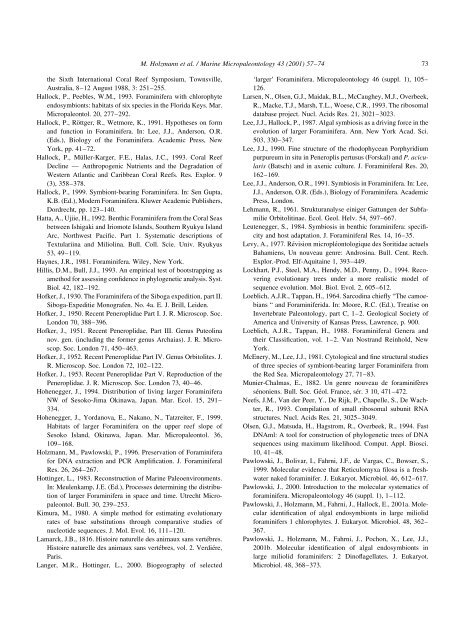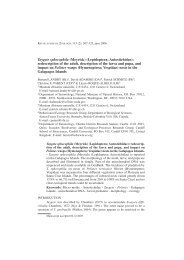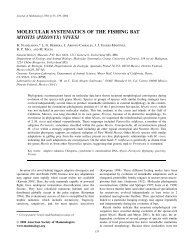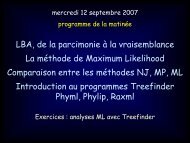Molecular phylogeny of large miliolid foraminifera - University of ...
Molecular phylogeny of large miliolid foraminifera - University of ...
Molecular phylogeny of large miliolid foraminifera - University of ...
You also want an ePaper? Increase the reach of your titles
YUMPU automatically turns print PDFs into web optimized ePapers that Google loves.
M. Holzmann et al. / Marine Micropaleontology 43 2001) 57±74 73the Sixth International Coral Reef Symposium, Townsville,Australia, 8±12 August 1988, 3: 251±255.Hallock, P., Peebles, W.M., 1993. Foraminifera with chlorophyteendosymbionts: habitats <strong>of</strong> six species in the Florida Keys. Mar.Micropaleontol. 20, 277±292.Hallock, P., RoÈttger, R., Wetmore, K., 1991. Hypotheses on formand function in Foraminifera. In: Lee, J.J., Anderson, O.R.Eds.), Biology <strong>of</strong> the Foraminifera. Academic Press, NewYork, pp. 41±72.Hallock, P., MuÈller-Karger, F.E., Halas, J.C., 1993. Coral ReefDecline Ð Anthropogenic Nutrients and the Degradation <strong>of</strong>Western Atlantic and Caribbean Coral Reefs. Res. Explor. 93), 358±378.Hallock, P., 1999. Symbiont-bearing Foraminifera. In: Sen Gupta,K.B. Ed.), Modern Foraminifera. Kluwer Academic Publishers,Dordrecht, pp. 123±140.Hatta, A., Ujiie, H., 1992. Benthic Foraminifera from the Coral Seasbetween Ishigaki and Iriomote Islands, Southern Ryukyu IslandArc, Northwest Paci®c. Part 1. Systematic descriptions <strong>of</strong>Textulariina and Miliolina. Bull. Coll. Scie. Univ. Ryukyus53, 49±119.Haynes, J.R., 1981. Foraminifera. Wiley, New York.Hillis, D.M., Bull, J.J., 1993. An empirical test <strong>of</strong> bootstrapping asamethod for assessing con®dence in phylogenetic analysis. Syst.Biol. 42, 182±192.H<strong>of</strong>ker, J., 1930. The Foraminifera <strong>of</strong> the Siboga expedition, part II.Siboga-Expeditie Monografen. No. 4a. E. J. Brill, Leiden.H<strong>of</strong>ker, J., 1950. Recent Peneroplidae Part I. J. R. Microscop. Soc.London 70, 388±396.H<strong>of</strong>ker, J., 1951. Recent Peneroplidae, Part III. Genus Puteolinanov. gen. including the former genus Archaias). J. R. Microscop.Soc. London 71, 450±463.H<strong>of</strong>ker, J., 1952. Recent Peneroplidae Part IV. Genus Orbitolites. J.R. Microscop. Soc. London 72, 102±122.H<strong>of</strong>ker, J., 1953. Recent Peneroplidae Part V. Reproduction <strong>of</strong> thePeneroplidae. J. R. Microscop. Soc. London 73, 40±46.Hohenegger, J., 1994. Distribution <strong>of</strong> living <strong>large</strong>r ForaminiferaNW <strong>of</strong> Sesoko-Jima Okinawa, Japan. Mar. Ecol. 15, 291±334.Hohenegger, J., Yordanova, E., Nakano, N., Tatzreiter, F., 1999.Habitats <strong>of</strong> <strong>large</strong>r Foraminifera on the upper reef slope <strong>of</strong>Sesoko Island, Okinawa, Japan. Mar. Micropaleontol. 36,109±168.Holzmann, M., Pawlowski, P., 1996. Preservation <strong>of</strong> Foraminiferafor DNA extraction and PCR Ampli®cation. J. ForaminiferalRes. 26, 264±267.Hottinger, L., 1983. Reconstruction <strong>of</strong> Marine Paleoenvironments.In: Meulenkamp, J.E. Ed.), Processes determining the distribution<strong>of</strong> <strong>large</strong>r Foraminifera in space and time. Utrecht Micropaleontol.Bull. 30, 239±253.Kimura, M., 1980. A simple method for estimating evolutionaryrates <strong>of</strong> base substitutions through comparative studies <strong>of</strong>nucleotide sequences. J. Mol. Evol. 16, 111±120.Lamarck, J.B., 1816. Histoire naturelle des animaux sans verteÂbres.Histoire naturelle des animaux sans verteÂbres, vol. 2. VerdieÂre,Paris.Langer, M.R., Hottinger, L., 2000. Biogeography <strong>of</strong> selected`<strong>large</strong>r' Foraminifera. Micropaleontology 46 suppl. 1), 105±126.Larsen, N., Olsen, G.J., Maidak, B.L., McCaughey, M.J., Overbeek,R., Macke, T.J., Marsh, T.L., Woese, C.R., 1993. The ribosomaldatabase project. Nucl. Acids Res. 21, 3021±3023.Lee, J.J., Hallock, P., 1987. Algal symbiosis as a driving force in theevolution <strong>of</strong> <strong>large</strong>r Foraminifera. Ann. New York Acad. Sci.503, 330±347.Lee, J.J., 1990. Fine structure <strong>of</strong> the rhodophycean Porphyridiumpurpureum in situ in Peneroplis pertusus Forskal) and P. acicularisBatsch) and in axenic culture. J. Foraminiferal Res. 20,162±169.Lee, J.J., Anderson, O.R., 1991. Symbiosis in Foraminifera. In: Lee,J.J., Anderson, O.R. Eds.), Biology <strong>of</strong> Foraminifera. AcademicPress, London.Lehmann, R., 1961. Strukturanalyse einiger Gattungen der SubfamilieOrbitolitinae. Ecol. Geol. Helv. 54, 597±667.Leutenegger, S., 1984. Symbiosis in benthic <strong>foraminifera</strong>: speci®cityand host adaptation. J. Foraminiferal Res. 14, 16±35.Levy, A., 1977. ReÂvision micropleÂontologique des Soritidae actuelsBahamiens, Un nouveau genre: Androsina. Bull. Cent. Rech.Explor.-Prod. Elf-Aquitaine 1, 393±449.Lockhart, P.J., Steel, M.A., Hendy, M.D., Penny, D., 1994. Recoveringevolutionary trees under a more realistic model <strong>of</strong>sequence evolution. Mol. Biol. Evol. 2, 605±612.Loeblich, A.J.R., Tappan, H., 1964. Sarcodina chie¯y ªThe camoebiansª and Foraminiferida. In: Moore, R.C. Ed.), Treatise onInvertebrate Paleontology, part C, 1±2. Geological Society <strong>of</strong>America and <strong>University</strong> <strong>of</strong> Kansas Press, Lawrence, p. 900.Loeblich, A.J.R., Tappan, H., 1988. Foraminiferal Genera andtheir Classi®cation, vol. 1±2. Van Nostrand Reinhold, NewYork.McEnery, M., Lee, J.J., 1981. Cytological and ®ne structural studies<strong>of</strong> three species <strong>of</strong> symbiont-bearing <strong>large</strong>r Foraminifera fromthe Red Sea. Micropaleontology 27, 71±83.Munier-Chalmas, E., 1882. Un genre nouveau de foraminifeÁresseÂnoniens. Bull. Soc. GeÂol. France, seÂr. 3 10, 471±472.Neefs, J.M., Van der Peer, Y., De Rijk, P., Chapelle, S., De Wachter,R., 1993. Compilation <strong>of</strong> small ribosomal subunit RNAstructures. Nucl. Acids Res. 21, 3025±3049.Olsen, G.J., Matsuda, H., Hagstrom, R., Overbeek, R., 1994. FastDNAml: A tool for construction <strong>of</strong> phylogenetic trees <strong>of</strong> DNAsequences using maximum likelihood. Comput. Appl. Biosci.10, 41±48.Pawlowski, J., Bolivar, I., Fahrni, J.F., de Vargas, C., Bowser, S.,1999. <strong>Molecular</strong> evidence that Reticulomyxa ®losa is a freshwaternaked foraminifer. J. Eukaryot. Microbiol. 46, 612±617.Pawlowski, J., 2000. Introduction to the molecular systematics <strong>of</strong><strong>foraminifera</strong>. Micropaleontology 46 suppl. 1), 1±112.Pawlowski, J., Holzmann, M., Fahrni, J., Hallock, E., 2001a. <strong>Molecular</strong>identi®cation <strong>of</strong> algal endosymbionts in <strong>large</strong> <strong>miliolid</strong>foraminifers 1 chlorophytes. J. Eukaryot. Microbiol. 48, 362±367.Pawlowski, J., Holzmann, M., Fahrni, J., Pochon, X., Lee, J.J.,2001b. <strong>Molecular</strong> identi®cation <strong>of</strong> algal endosymbionts in<strong>large</strong> <strong>miliolid</strong> foraminifers: 2 Dino¯agellates. J. Eukaryot.Microbiol. 48, 368±373.






